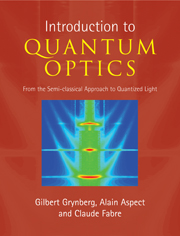Book contents
- Frontmatter
- Contents
- Foreword
- Preface
- Acknowledgements
- Part I Semi-classical description of matterlight interaction
- Part II Quantum description of light and its interaction with matter
- Part III Applying both approaches
- 7 Nonlinear optics. From the semi-classical approach to quantum effects
- Complement 7A: Parametric amplification and oscillation. Semi-classical and quantum properties
- Complement 7B: Nonlinear optics in optical Kerr media
- 8 Laser manipulation of atoms. From incoherent atom optics to atom lasers
- Complement 8A: Cooling to sub-recoil temperatures by velocity-selective coherent population trapping
- Index
7 - Nonlinear optics. From the semi-classical approach to quantum effects
Published online by Cambridge University Press: 05 August 2012
- Frontmatter
- Contents
- Foreword
- Preface
- Acknowledgements
- Part I Semi-classical description of matterlight interaction
- Part II Quantum description of light and its interaction with matter
- Part III Applying both approaches
- 7 Nonlinear optics. From the semi-classical approach to quantum effects
- Complement 7A: Parametric amplification and oscillation. Semi-classical and quantum properties
- Complement 7B: Nonlinear optics in optical Kerr media
- 8 Laser manipulation of atoms. From incoherent atom optics to atom lasers
- Complement 8A: Cooling to sub-recoil temperatures by velocity-selective coherent population trapping
- Index
Summary
Introduction
In 1961, just a few months after Maiman invented the ruby laser, Franken focused the pulses emitted from such a laser, of wavelength 694 nm, on a quartz plate, and examined the spectrum of the light transmitted using a simple prism (see Figure 7.1). He thus discovered that ultra-violet light of wavelength 347 nm was emerging from the quartz plate. Clearly, as it propagated through the quartz, the light of frequency ω had generated the second harmonic, of frequency 2ω.
It thus transpires that in optics, as in any other part of physics, a system subjected to a strong enough sinusoidal excitation will leave the linear response regime. Nonlinearities cause harmonics of the excitation frequency to appear.
But what intensity is needed before nonlinear effects will appear? One might think that a natural scale would be the electric field of the nucleus at the location of an atomic electron. In the case of the hydrogen atom in its ground state, this field is about, or 3 × 1011 V.m−1. (Here e is the charge of the electron, and a0 the Bohr radius, of the order of 5 × 10−11 m). In fact, experiment shows that, in the transparency zone of a dielectric material like quartz, a field of just 107 V.m−1 (corresponding to a light intensity of 2.5 kW.cm−2) is sufficient for nonlinear effects to appear perturbatively.
- Type
- Chapter
- Information
- Introduction to Quantum OpticsFrom the Semi-classical Approach to Quantized Light, pp. 529 - 559Publisher: Cambridge University PressPrint publication year: 2010



